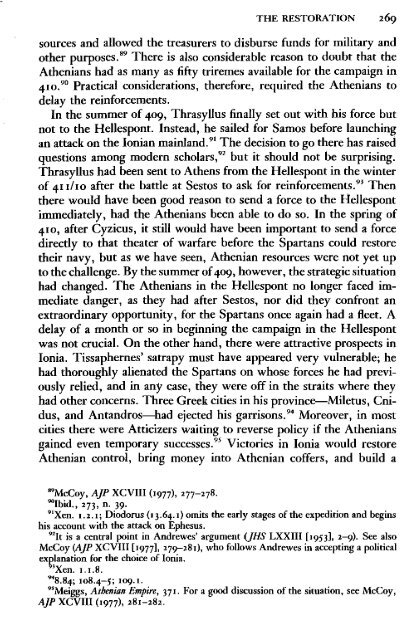The Fall of the Athenian Empire-(A New History of the Peloponnesian War) Donald Kagan - (1987)
MACEDONIA is GREECE and will always be GREECE- (if they are desperate to steal a name, Monkeydonkeys suits them just fine) ΚΑΤΩ Η ΣΥΓΚΥΒΕΡΝΗΣΗ ΤΩΝ ΠΡΟΔΟΤΩΝ!!! Strabo – “Geography” “There remain of Europe, first, Macedonia and the parts of Thrace that are contiguous to it and extend as far as Byzantium; secondly, Greece; and thirdly, the islands that are close by. Macedonia, of course, is a part of Greece, yet now, since I am following the nature and shape of the places geographically, I have decided to classify it apart from the rest of Greece and to join it with that part of Thrace which borders on it and extends as far as the mouth of the Euxine and the Propontis. Then, a little further on, Strabo mentions Cypsela and the Hebrus River, and also describes a sort of parallelogram in which the whole of Macedonia lies.” (Strab. 7.fragments.9) ΚΚΕ, ΚΝΕ, ΟΝΝΕΔ, ΑΓΟΡΑ,ΕΚΚΛΗΣΙΑ,ΝΕΑ,ΦΩΝΗ,ΦΕΚ,ΝΟΜΟΣ,LIFO,MACEDONIA, ALEXANDER, GREECE,IKEA
MACEDONIA is GREECE and will always be GREECE- (if they are desperate to steal a name, Monkeydonkeys suits them just fine)
ΚΑΤΩ Η ΣΥΓΚΥΒΕΡΝΗΣΗ ΤΩΝ ΠΡΟΔΟΤΩΝ!!!
Strabo – “Geography”
“There remain of Europe, first, Macedonia and the parts of Thrace that are contiguous to it and extend as far as Byzantium; secondly, Greece; and thirdly, the islands that are close by. Macedonia, of course, is a part of Greece, yet now, since I am following the nature and shape of the places geographically, I have decided to classify it apart from the rest of Greece and to join it with that part of Thrace which borders on it and extends as far as the mouth of the Euxine and the Propontis. Then, a little further on, Strabo mentions Cypsela and the Hebrus River, and also describes a sort of parallelogram in which the whole of Macedonia lies.”
(Strab. 7.fragments.9)
ΚΚΕ, ΚΝΕ, ΟΝΝΕΔ, ΑΓΟΡΑ,ΕΚΚΛΗΣΙΑ,ΝΕΑ,ΦΩΝΗ,ΦΕΚ,ΝΟΜΟΣ,LIFO,MACEDONIA, ALEXANDER, GREECE,IKEA
Create successful ePaper yourself
Turn your PDF publications into a flip-book with our unique Google optimized e-Paper software.
THE RESTORATION 271<br />
which would have allowed <strong>the</strong>m to threaten <strong>the</strong> city from two directions.<br />
Instead <strong>of</strong> making an immediate assault, however, <strong>the</strong>y continued<br />
inland to Lydia, where <strong>the</strong>y did much damage and collected a<br />
great deal <strong>of</strong> booty, but once again <strong>the</strong> failure <strong>of</strong> <strong>the</strong> commander to<br />
impose strict discipline proved costly. Stages, <strong>the</strong> Persian commander<br />
in <strong>the</strong> area, caught <strong>the</strong> A<strong>the</strong>nians scattered and in disarray, killed some,<br />
and would have done even more damage had not <strong>the</strong> A<strong>the</strong>nian cavalry<br />
come to <strong>the</strong> rescue. Thrasyllus turned back to <strong>the</strong> coast, intending to<br />
sail against Ephesus.<br />
Once again <strong>the</strong> ravaging and delay gave <strong>the</strong> enemy warning and<br />
time to rally its troops. It was not until <strong>the</strong> seventeenth day after <strong>the</strong><br />
raid that Thrasyllus set sail for Ephesus. By that time Tissaphernes<br />
was on <strong>the</strong> scene with a large army, swelled by <strong>the</strong> crews <strong>of</strong> twentyfive<br />
Syracusan ships and two from Selinus, for <strong>the</strong> Carthaginian attack<br />
on Sicily had not yet begun. Tissaphernes used <strong>the</strong> time well, sending<br />
horsemen into <strong>the</strong> countryside, urging <strong>the</strong> people <strong>of</strong> <strong>the</strong> neighborhood<br />
"to come to <strong>the</strong> aid <strong>of</strong> Artemis. " 99 We should not forget that <strong>the</strong> last<br />
event reported by Thucydides is Tissaphernes' sacrifice to Artemis at<br />
Ephesus. 100 We may be sure that it was public and well advertised.<br />
<strong>The</strong> sa trap must have carefully nourished a reputation for piety toward<br />
<strong>the</strong> Greek gods and especially Artemis <strong>of</strong> <strong>the</strong> Ephesians. His appeal,<br />
<strong>the</strong>refore, will have been both plausible and effective. Thrasyllus<br />
landed at daybreak and split his forces: he landed his hoplites on one<br />
side <strong>of</strong> <strong>the</strong> city, at <strong>the</strong> foot <strong>of</strong> Mt. Coressus, and <strong>the</strong> o<strong>the</strong>r troops near<br />
a marsh on <strong>the</strong> opposite side. This may have seemed a clever strategy<br />
to Thrasyllus, but it turned out to be disastrous. <strong>The</strong> enemy concentrated<br />
its forces and attacked <strong>the</strong> hoplites first, routing <strong>the</strong>m, killing<br />
about a hundred, and driving <strong>the</strong> rest to <strong>the</strong> sea. <strong>The</strong>n <strong>the</strong>y turned<br />
<strong>the</strong>ir full force against <strong>the</strong> troops by <strong>the</strong> marsh, once again routing <strong>the</strong><br />
A<strong>the</strong>nians and killing ano<strong>the</strong>r 300. <strong>The</strong> Ephesians set up two trophies,<br />
one at each battle site, and gave prizes for valor to <strong>the</strong> Sicilians, who<br />
had especially distinguished <strong>the</strong>mselves, and to individuals among<br />
<strong>the</strong>m for particularly conspicuous bravery.'"'<br />
wlbid., 4-6.<br />
100 8.1()().<br />
101 Xen. 1.2. ro. All <strong>of</strong> <strong>the</strong> Sicilians were invited to settle in Ephesus as resident aliens<br />
freed from <strong>the</strong> taxes o<strong>the</strong>r such metics paid. Later, when <strong>the</strong> Carthaginians destroyed<br />
Selinus, its people were <strong>of</strong>fered Ephesian citizenship. See now <strong>the</strong> new papyrus fragment<br />
<strong>of</strong> P. published by L. Koenen in Studio Papyrologica XV (1976), 55-76. It agrees<br />
with <strong>the</strong> account <strong>of</strong> <strong>the</strong> o<strong>the</strong>r sources and adds some details.

















